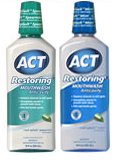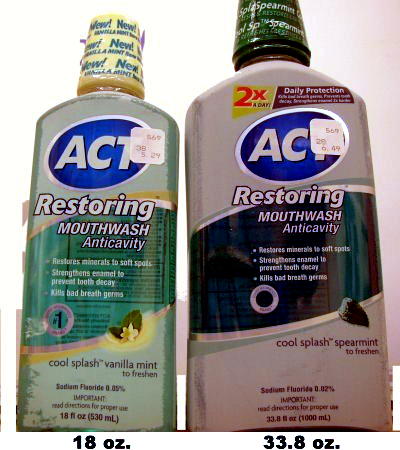 When MrConsumer’s dentist advised him that a new cavity might be in its earliest stages of development, he checked out fluoride rinses that claim to restore minerals to weak spots in tooth enamel and prevent cavities.
When MrConsumer’s dentist advised him that a new cavity might be in its earliest stages of development, he checked out fluoride rinses that claim to restore minerals to weak spots in tooth enamel and prevent cavities.
The granddaddy of brands is Act, formerly owned by Johnson & Johnson, and recently acquired by a company called Chattem.
Act comes in two sizes: 18 ounce and 33.8 ounce. Luckily for MrConsumer, Rite Aid had the large size on sale last week, and there was a rebate. It was a seeming no-brainer to buy the big size.

Upon closer examination of the ingredients label, MrConsumer found a shocker:
*MOUSE PRINT: The larger bottle has less than half the strength of fluoride compared to the smaller one.

Now who would ever expect that a different size bottle would have a different strength of the active ingredient? In fact, if you look at the larger bottle, there is a “2x” on it. Without reading carefully, one might assume that “2x” means twice the strength or twice the size, but certainly never half the potency. A closer examination reveals that is says “2x a day”. Okay, so you can use the product twice daily.
As it turns out, the company says the smaller bottle is a once a day product, and the larger one is a twice a day product. Apparently you get the equivalent amount of fluoride using the diluted version two times a day.
Nonetheless, with such an inconspicuous but important difference, countless customers in the habit of using the product once a day may buy the large size, rinse as usual, and unwittingly not get the protection they expect.

Without the rebate the larger bottle cost 131% more per day of use than the smaller bottle. It appears the 18 oz. bottle cost $5.29 (18 days of use), the 33.8 oz. bottle cost $6.49 (17 days of use). It breaks down to .29 cents a day for the 18 oz. bottle and .38 cents a day for the 33.8 oz. bottle.
Slick the way the company appears to be giving you more applications at a cheaper price, but it is really just the opposite.
It says right on the bottle “IMPORTANT read directions for proper use”. The maufacturer can’t be held responsible for consumers not using the product correctly. Is there a benefit to rinsing twice a day with a diluted solution, as opposed to only once a day with a stronger solution? If so, then maybe there is a justifiable reason for an increased cost per use from a benefits perspective.
I think the point is, that people are mislead into thinking that they are simply buying a bigger bottle for a bargain when in fact, it is a different product. If I believe I am buying the same old product then why would be the reason for me to re-read the instructions? Unless I’m buying a different product or brand it would be impossible for me to read every label of every product every time I go shopping!!!
Listerine has a similar deceptive practice where the bottle proclaims “protects your teeth and gum for 24 hours.” But when you read the small print it says you must rinse every 12 hours for the 24 hour protection
!!!
Are you kidding me? Why not say “Protects your teeth and gums for a full year!!!” (when rinsing with Listerine 730 times a year, twice a day).
They teach us in grade school to always find the lowest common denominator (or something like that) so 2/24 = 1/12. If the makers of Listerine were honest, it would say “12 hour protection.”
@ shawn: the manufacturer can’t be held responsable. True. As a consumer, I would expect a manufacturer to inform me in a clear and straightforward way about the product. Quite frankly, I can’t imagine a manufacturer would want to misinform his customers. But then again, I am not manufacturer, and most likely because I am too honest to be able to sell my products decently.
The manufacturer should have changed the label to say, for example: “New Improved Twice-A-Day Formula (read directions for more information)”
Fairly truthful and then it would have made this article moot.
It’s a little hard to read the graphic, but it does seem to say “a day” within the 2x rectangle. But the total design of the product would make you think only the volume and flavor, Vanilla vs Mint are the only differences in the contents, Certainly the extremely reduced size of “a day” is an typical example of the usual fine print deception.
Pietro – You’re right. It does say “a day” right on the label in plain English. There is absolutely nothing deceptive about this product! Only those that are too lazy to read and follow the product instructions are getting “fooled” by this. Grow up and learn how to be responsible for yourself. Mommy, and government regulation, are not here to hold your hand from being lazy or illiterate!
And Jasper, if you don’t have the 10 seconds i takes to read the product instructions, you’re nothing but lazy and you deserve what you get if you use the product incorrectly.
Peace Out Dudes!
Shawn,
Glad to hear that things are going so well for you, that you have the leisure time to carefully read the label of every product you purchase. You are probably the only person I’ve every heard of that has read–at least once–the label of every product in their shopping cart. [comment edited]
I noticed the difference the second time I went to buy ACT in the larger bottle. The first time I was too busy trying to figure out if the new “restoring” formula actually did anything (I kind of doubt that it does). Anyway, I do read product labels, but I think a sneaky trick is being pulled here. Because this was a brand I had been using for years I didn’t fully read the fine print because I thought it would be the same. Intuitively there would seem to be little reason for a manufacturer to do the twice a day thing, so it probably catches many people off guard. If you think hard enough, maybe twice a day is better, but that’s not what people expect in a larger size.
If manufacturers do not want busy people to make mistakes and thus foster a good relationship with their customers, then the onus is on them to make the difference clear enough for the vast majority to catch.
If everyone walked around with a calculator and read every label with diligence, then there wouldn’t be a need for MousePrint.org.
Don’t forget the magnifying glass. You’ll probably need that also. I think previous posters are absolutely correct in saying that we can read labels and find out many of the things reported on this site. I believe the point is more so that manufacturers know that people do not thoroughly read labels for various reasons. These same manufacturers prey on consumers by fully disclosing in a manner that is specifically designed to take advantage of the average consumer. Can we protect ourselves by reading every word on every label? Most times. Is it a shady business practice to purposely try to obscure product information? Absolutely.
This is deceptive because of expectations. When you see two products from the same manufacturer with the same name and same product, you expect them to be the same.
If two gas pumps looked exactly the same but one discretely touted 84 octane (which will typically destroy most engines) would you notice? This happened to me in Utah at a Walmart. Fortunately I noticed halfway through and offset it with a much higher octane.
Expectations are a large part of survival. Once you learn something, you don’t expect to have to relearn it every time, but it seems that Act took advantage of this human trait.
@ shawn
So let me ask you, then: Why is the “a day” part printed in such small type? There’s certainly space for it to be bigger, and more clear. It isn’t though, and I share the suspicion that the intention of the smaller type is to reduce the clarity of the statement.
And that’s the issue at hand. It’s not that it’s *impossible* to read the label, just that the company is likely intentionally making it *harder*. Isn’t it annoying when someone makes life *harder* for you than it needs to be?
This country is overrun with cheats and liars. It’s so pathetic.
For the Bloggers who say to read the labels I agree, but who has the time?
Most people are so busy working 2-3 jobs to pay for it we don’t have time.
Deceptive advertising is not illegal but it should be. What it hurts is your future earnings.
The government sees little change in inflation because they mainly look at prices. They post thier (BS)
figures and many companies use theses numbers to help figure raises for employees. Because of this the average Joe has been experiencing some of the lowest wage growth in decades, especially those on fixed incomes. I have learned to spot deceptive advertising quite well but it’s become so blatant and widespread it’s almost hopeless trying to keep up
with it. If companies just raised prices accordingly and kept product quality the same, we would see the real
condition of our economy.
Act Fluoride rinse isn’t being deceptive. Fluoride in toothpaste or rinse attains maximum benefit when used several times daily with these low doses. Each time, the enamel remineralization process is aided by exposure to that type of fluoride. Our frequent, daily habits of snacking, drinking acidic drinks (sports drinks, flavored waters, energy drinks, carbonated beverages, etc.), and eating normal meals produce acids that linger in our mouth and are capable of beginning tooth decay. Some people are excellent 3X a day brushers and flossers using a fluoride toothpaste, but have signs of acidic breakdown. They may benefit from an additional rinse(s) of fluoride. Some people can’t remember to rinse more than once daily. Some people take medications that greatly reduce their salivary flow (sometimes unnoticed) causing constant acidity of the mouth. Both Act fluoride strengths offer direct benefits, but deciding which strength to use and frequency should be asked of your dental professional. Often, our office recommends using a rinse twice daily.
I think buying either container is a good buy.
(If I remember correctly, I think fluoride containers must meet federal size guidelines for safety so an accidental ingestion by a very young child wouldn’t result in injury. So, perhaps the larger container cannot have the higher concentration of fluoide.)